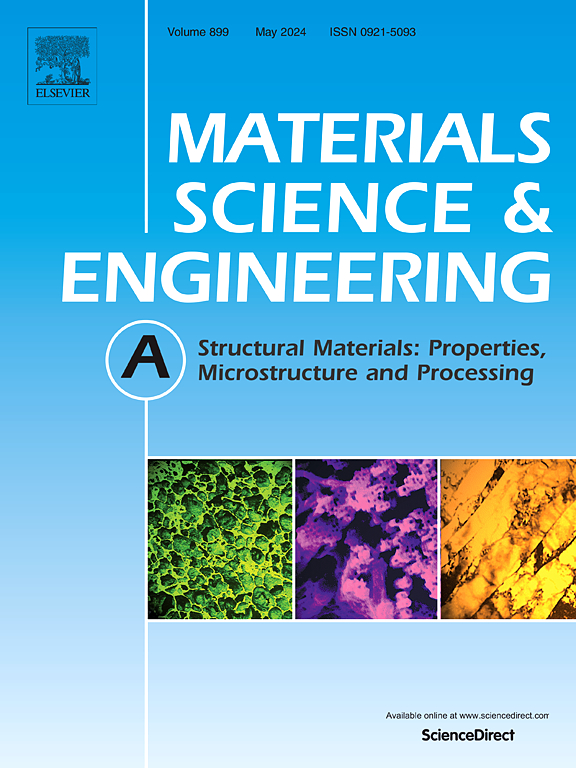宽谱含W NiW合金的逆Hall-Petch和纳米晶-非晶转变
IF 7
2区 材料科学
Q1 MATERIALS SCIENCE, MULTIDISCIPLINARY
引用次数: 0
摘要
制造晶粒尺寸小于10nm的金属材料,特别是在2.4到7.2 nm之间的金属材料,是一个挑战。然而,在这个范围内准确识别Hall-Petch击穿是至关重要的。此外,对于纳米晶体转变为非晶材料时强度的变化存在不同的观点。本研究通过调节电流密度和温度,制备了1.9 ~ 15.8 nm的非晶或纳米NiW镀层。对钨原子固溶体下的微观组织进行了表征,并测量了表面硬度。结果表明:FCC镍合金中钨固溶细化了晶粒尺寸,强度服从Hall-Patch关系,而纳米晶NiW合金的硬度在5.79 GPa (% W)处达到最大值,临界点为5.9 nm,明显超过纯镍在22.0 nm处的5.29 GPa硬度。此后,开始出现逆转的Hall-Petch异常现象。Ni-15.0 (% W)退火合金在5.0 nm处也有类似的趋势和临界点。在转变为非晶态后,硬度进一步升高,在%W时,Ni-20.9的硬度达到8.95 GPa。计算了不同钨原子含量下的固溶硬化值。表明晶粒尺寸小于10.0 nm的纳米晶NiW的固溶极限扩大。原子固溶体去除硬化后,在膨胀偏移至8.6 nm的临界点处,出现了类似的Hall-Petch击穿现象,接近镍电镀层的临界点。本文章由计算机程序翻译,如有差异,请以英文原文为准。
Inverse Hall-Petch and nanocrystal-amorphous transition of broad-spectrum W content NiW alloys
Fabricating metallic materials with grain sizes below 10 nm, particularly in the range between 2.4 and 7.2 nm, poses a challenge. However, it is crucial to accurately identify Hall-Petch breakdown within this range. Moreover, there are differing opinions regarding the change in strength that occurs when nanocrystals transform into amorphous materials. This study involved the electroplating preparation of amorphous or nanometer NiW coatings spanning 1.9–15.8 nm by adjusting current density and temperature. The microstructure under tungsten atoms solid solution was characterized and measured surface hardness. The results revealed that the tungsten solid solution in FCC Ni alloy refines grain size and the strength follows the Hall-Patch relationship while the hardness of nanocrystal NiW alloy with 12.3 at% W regional maximum at 7.79 GPa at the critical point of 5.9 nm, significantly surpassing the 5.29 GPa hardness of pure nickel at 22.0 nm. After that, reverse Hall-Petch abnormal phenomenon begin. The annealed alloy of Ni-15.0 at% W had the similar trend and critical point at 5.0 nm. Following the transformation into an amorphous state, hardness further rises, reaching a pinnacle of 8.95 GPa of Ni-20.9 at%W. The values of solid solution hardening under various content of tungsten atoms were calculated. It suggests that the solid solution limitation of nanocrystal NiW which grain size bellowed 10.0 nm expanded. After removing the hardening by atoms solid solution, the similar Hall-Petch breakdown phenomenon was observed while the critical point was expansion offset to 8.6 nm which was approaching the critical point of nickel electrodeposited coating.
求助全文
通过发布文献求助,成功后即可免费获取论文全文。
去求助
来源期刊

Materials Science and Engineering: A
工程技术-材料科学:综合
CiteScore
11.50
自引率
15.60%
发文量
1811
审稿时长
31 days
期刊介绍:
Materials Science and Engineering A provides an international medium for the publication of theoretical and experimental studies related to the load-bearing capacity of materials as influenced by their basic properties, processing history, microstructure and operating environment. Appropriate submissions to Materials Science and Engineering A should include scientific and/or engineering factors which affect the microstructure - strength relationships of materials and report the changes to mechanical behavior.
 求助内容:
求助内容: 应助结果提醒方式:
应助结果提醒方式:


